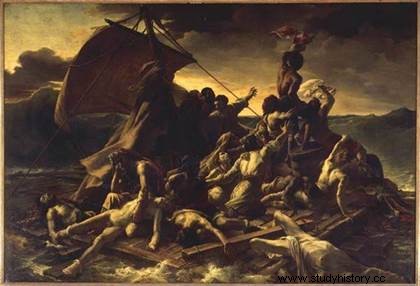 The "romanticism is a European literary and artistic movement born at the end of the 18th century, and which reached its peak during the 19th century. This new form of sensitivity expresses the heartbreak of amorous passions and the anguish of human loneliness. Around 1800, the whole of Europe was affected by the romantic movement, in reaction to the rationalism of the Age of Enlightenment. In France, the classical tradition has dominated literature and the arts for almost two centuries, it stifled all subjectivity until the Revolution. From then on, romanticism is both later and more violent there, the French romantic authors will have a lot to do to impose themselves.
The "romanticism is a European literary and artistic movement born at the end of the 18th century, and which reached its peak during the 19th century. This new form of sensitivity expresses the heartbreak of amorous passions and the anguish of human loneliness. Around 1800, the whole of Europe was affected by the romantic movement, in reaction to the rationalism of the Age of Enlightenment. In France, the classical tradition has dominated literature and the arts for almost two centuries, it stifled all subjectivity until the Revolution. From then on, romanticism is both later and more violent there, the French romantic authors will have a lot to do to impose themselves.
The agony of classicism
The term "romantic" comes from the German adjective romantisch. It has a complex and vague meaning. Some associate it with the term “novel” which first means “vulgar language (as opposed to Latin)”, then “narrative in the vulgar language”. But the German Romantic Friedrich von Schlegel opposes it to “classical” when speaking of literature. It is therefore a question of the refusal of an outdated aesthetic. A pre-Romantic movement developed in Germany and England from the end of the 18th century. As for romanticism, it appeared around 1800 in Germanic literature. In France, we do not speak of romanticism before 1815. Only Rousseau and Chateaubriand renew the classic themes and sensibility.
 Apart from these isolated experiences, we stick to the rules of separation of genres, to ancient subjects, to formal games and to a certain reserve. Poetry lacks breath. It is meant to be didactic and becomes boring. It imitates without genius, without even originality, the productions of the "generation of models" (17th century). Playwrights are also content with pale imitations of Racine.
Apart from these isolated experiences, we stick to the rules of separation of genres, to ancient subjects, to formal games and to a certain reserve. Poetry lacks breath. It is meant to be didactic and becomes boring. It imitates without genius, without even originality, the productions of the "generation of models" (17th century). Playwrights are also content with pale imitations of Racine.
Classicism is dying. A good part of the public demands a radical change because, following the recent political and social upheavals, the dramaturgical rules lose their direction and their flavor. This audience enjoys Shakespeare's theatre, Walter Scott's historical novels and Goethe's The Sorrows of Young Werther (1774). As in other European countries, it is very interested in folklore.
Literary romanticism in France
Two fundamental works by Mme de Staël (1766-1817) call for a literary revival in France:On literature considered in its relationship with social institutions (circa 1800) and From Germany (1813). The author emphasizes the demands of his period. In the name of aesthetic relativity, Mme de Staël calls for a decompartmentalization of genres to free sensitivity and individualism.
 A generation of romantic writers emerged under the Restoration, although many authors remained classical. The latter disdain the taste for the Middle Ages, considered for three centuries as a period of decadence. From 1820, the romantics met in Charles Nodier's salon in the Arsenal library. They quickly made a name for themselves with the Poetic Meditations for Lamartine (1820), the Odes for Victor Hugo (1822) and the first Poems for Vigny.
A generation of romantic writers emerged under the Restoration, although many authors remained classical. The latter disdain the taste for the Middle Ages, considered for three centuries as a period of decadence. From 1820, the romantics met in Charles Nodier's salon in the Arsenal library. They quickly made a name for themselves with the Poetic Meditations for Lamartine (1820), the Odes for Victor Hugo (1822) and the first Poems for Vigny.
If Hugo remained relatively moderate at the beginning of the 1820s, he became the leader of the movement in 1827, with his preface by Cromwell, a veritable literary manifesto. The theatre, mirror of universal life, must not respect the rules of propriety which place a veil between the drama represented and the spectator. Hugo advocates the juxtaposition of the sublime and the grotesque within the same piece. He rebels against the rule of three units.
His claims, shocking to the eyes of the classics, culminated in the Battle of 1830 , when he had Hernani or Castilian Honor represented , at the Comedie Francaise. If some stop the romantic period at 1848, they neglect the fact that the spirit of this movement does not fade in a few years. The opposition to tradition has marked people's minds to this day and the so-called symbolist writers (Baudelaire, Mallarmé, Verlaine, Rimbaud, etc.) remain the direct heirs of the movement, without however recognizing it.
Alfred de Musset's plays are representative of 19th century romantic theatre. They mix light themes (love plot, fanciful characters) with dramatic elements (the death of one of the protagonists). The heroes of Musset meet a tragic destiny:this is the case, for example, of Coelio in Les Caprices de Marianne or Lorenzaccio, a young debauchee who tries to free his people and who dies despised by all. Through them, the author expresses his disappointed hopes and his unhappiness. These profound works are among the most famous of French theater today.
In the middle of the 19th century, romantic sensibility gave way to the development of a “realist” current carried by Baudelaire, Hugo or Balzac.
French Romanticism in the arts
In the pictorial field, David reigns over painting until 1815. He draws inspiration from Antiquity and develops static and austere compositions. His pupil, Gros, quickly broke with the austerity of his master. He innovates with his chromatic power and his epic breath, visible in Bonaparte visiting the plague victims of Jaffa (1804), a painting that shocked supporters of classical aesthetics. Two great French painters recognize their filiation with Gros:Théodore Géricault and Eugène Delacroix. The Raft of the Medusa (1819) by Géricault responds to the academic tradition.
 On the other hand, the theme turns out to be purely romantic. The painter refers to a news item. On July 16, 1816, a ship named La Méduse sank. One hundred and forty-nine survivors board a raft. Fifteen survivors are picked up aboard the Argus. The others were thrown into the water or devoured. Géricault expresses the full intensity of the drama when the survivors see the Argus. In Paris, conservative journalists violently attacked this web in which they saw criticism of the regime. On the other hand, in London, it met with great success and appeared as a manifesto of the romantic school. Through its subject, it also becomes the symbol of a generation without a guide.
On the other hand, the theme turns out to be purely romantic. The painter refers to a news item. On July 16, 1816, a ship named La Méduse sank. One hundred and forty-nine survivors board a raft. Fifteen survivors are picked up aboard the Argus. The others were thrown into the water or devoured. Géricault expresses the full intensity of the drama when the survivors see the Argus. In Paris, conservative journalists violently attacked this web in which they saw criticism of the regime. On the other hand, in London, it met with great success and appeared as a manifesto of the romantic school. Through its subject, it also becomes the symbol of a generation without a guide.
In 1831, Delacroix completed Liberty Leading the People to commemorate the revolution of July 1830. He demonstrates his sense of drama, movement and color. The bare-chested woman represents freedom and victory. Delacroix also shows a taste for oriental subjects that can also be found in Hugo. In the musical field, French Romanticism is represented by Hector Berlioz and César Franck.
Bibliography
- Romanticism in France and Europe, by Gérard Gengembre. Pocket, 2003.
- History of Romanticism, by Théophile Gautier. The Untraceable, 1993.
- French romanticism, an essay on the revolution in feelings and ideas in the 19th century, by Pierre Lasserre. Hachette, 2016.
